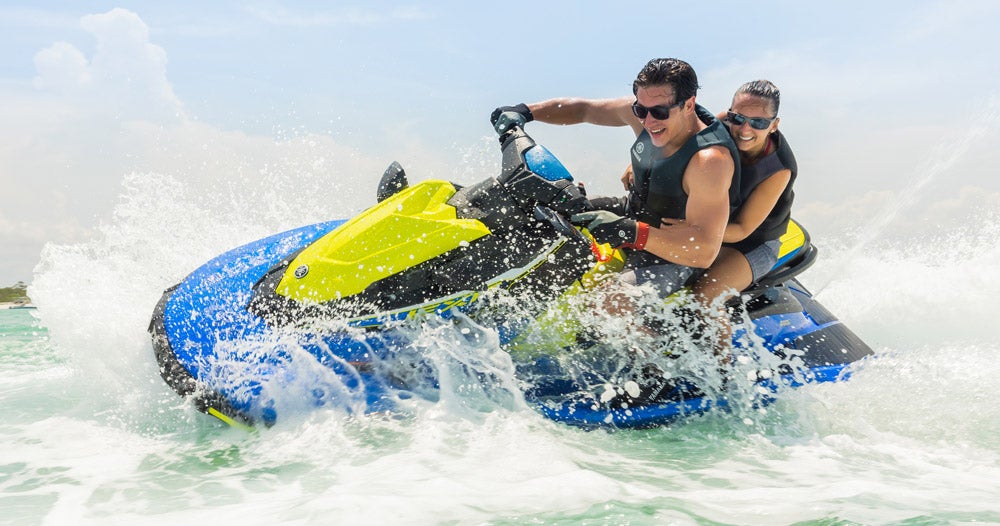2019 Yamaha EXR Review
Yamaha adds a significant performance boosts to the EX family with the introduction of the new 2019 Yamaha EXR.
Engine: Three-cylinder 1,049cc
Fuel Capacity: 13.2 gal.
Stowage Capacity: 7.7 gal.
Weight: 540 lbs
Seating Capacity: 3
MSRP: $9,299
Yamaha’s FX makeover may seem like the biggest news from the brand for 2019, but the “smallest” news is not to be overlooked – the fact that the diminutive Rec Lite EX series has gained a fourth model for the new year – the 2019 Yamaha EXR.
It’s focus? You only need see the “R” at the end of the name to guess what Yamaha has in store.
The R in EXR
That R graces the VXR and has now made a comeback on the GP1800R, so it’s safe to say its inclusion on an EX model has something to do with performance. Or perhaps more specifically, horsepower-to-weight ratio.
The 2019 Yamaha EXR build starts with the lightest weight version of NanoXcel, the brand’s vaunted NanoXcel 2 construction material, to fabricate both the hull and deck. Nano2 trims significant weight from the craft, dropping it to 540 pounds (in comparison the next-in-line EX Deluxe weighs in at 600). On the other half of that power-to-weight ratio, a new engine control unit (ECU) bumps up the horsepower of the 1,049cc TR-1 engine by 10% to an even 110hp. That engine now revs to 8000 rpm compared to the former 7300 rpm limit. Final changes include a new top-loader intake grate and 40mm pump extension.
Other standout features follow the Deluxe specs with the inclusion of RiDE, Yamaha’s now-familiar dual-throttle system. RiDE adds a secondary throttle for controlling reverse thrust. Use it to slow the craft rapidly from speed of deliver precise low-speed control around the marina or launch ramp. Additional features include a two-tone cut and sew seat, reboarding step, mirrors and “advanced” graphics package. In the latter case, that turns out to be an Azure Blue hull and deck with neon yellow accents and saddle. Cost is a $500 premium over the EX Deluxe.
Top speed? Fifty-four miles per hour is the benchmark set for the 2019 Yamaha EXR, which is about four miles per hour faster than the Rec Lite standard, including Yamaha’s EX. The response, however, is equally notable, with a quicker holeshot and the pump extension resulting in a more playful, responsive, and aggressive attitude…or probably just what you’d expect from a 10’ 3”, 540-pound boat with 110 hp.
Easy “E”
Apart from the performance-minded upgrades, the EXR still shares the qualities that made the EX series a hit for those looking for a simpler, smaller, more affordable watercraft. Yamaha may have followed the Sea-Doo SPARK into the Rec Lite category, but the company charted their own path by sticking to standards like fiberglass-based Sheet Molding Compound (SMC) and maintaining a double-digit fuel capacity and standard storage. The latter may be minimal at 7.7 gallons, but it’s centered around a deep glovebox that keeps frequently accessed items readily at hand. To be fair, however, the bow storage is quite shallow.
Some cost-cutting measures were handled in clever ways. A smaller, narrower craft means a smaller, narrower saddle is necessary. Yamaha maintained engine access by mounting that saddle atop a broader, composite sub-cowling. Typical maintenance items are still easily reached under the saddle. Should more extensive access be required, the sub-cowling unbolts to expose the entire engine. A reboarding step becomes a simple mini-step to starboard. The flywheel and coupler are one-piece, as is the molded pump stator and impeller housing.
Small Packages
With 100hp, better standard storage and fuel capacity, and arguably a better presence in the water with the occasional third passenger (especially when conditions turn rough), the EX already held a slight advantage over the SPARK in terms of the spec sheet. For those that really want to play around on a small, sporty craft that advantage has now likely stretched further in Yamaha’s direction, although the SPARK can still feel like the more playful craft at times. That advantage comes at a cost certainly — the 2019 Yamaha EXR retails for $9,299 costs about $1,700 more than the most similarly equipped SPARK. Those who like the EXR’s “pocket rocket” feel, however, should be thrilled at what the R adds to the EX.
In short, good things really do still come in small packages.
Get PersonalWatercraft.com in your Inbox!
Like PersonalWatercraft.com on Facebook
Comments
Most Popular

Remembering the Sea-Doo XP

2025 Yamaha JetBlaster PRO 2-Up Review

2024 Yamaha GP HO Review

2024 Kawasaki Jet Ski STX 160X Review

2017 Kawasaki Jet Ski Ultra 310LX Review


















 Your Privacy Choices
Your Privacy Choices